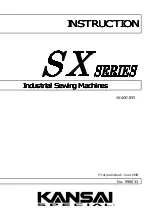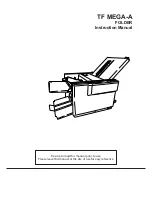
T-8421C, 8422C, 8452C, 8722C, 8752C
4. PREPARATION BEFORE SEWING
26
4-9. Corner sewing method (T-8452C, 8752C)
NOTE:
If using this machine in place of a single-needle machine, remove the needle which is not being used. In such cases, do not
use the procedures given below to stop the unused needle bar from moving, otherwise damage to the machine may result.
4-9-1. To stop the needle bars (right and left)
Operate the stop lever after the needle has penetrated the
material and has stopped moving.
Do not sew at speeds of over 1,000 sti/min while one of the
needle bars has been stopped.
<To stop operation of the left needle bar>
Move the stop lever (1) to the “L” position.
<To stop operation of the right needle bar>
Move the stop lever (1) to the “R” position.
<To resume twin-needle sewing>
Press the push lever (2).
The stop lever (1) will then return to its original position
automatically.
4-9-2. Number of stitches: quick-reference guide
<For 1/4” needle width>
Determine the stitch length from the chart above to make beautiful corner stitching.
The number of stitches of the outer needle varies according to the combination of sewing angle and stitch length.
[Example]
For a sewing angle of 40
°
and a stitch length of 2.9 mm, the number of stitches becomes 6.
3131M
30°
40°
50°
60°
70°
80°
90°
100° 110° 120° 130°
140°
2 4.6
3.8
3.2
2.7
2.2
1.8
1.5
1.1
3
4.6
3.5
3.0
2.5
2.1
1.8 1.5 1.2
4 4.4
3.4
2.8
2.3
1.9
1.6
1.3
5 4.8
3.5
2.7
2.2
1.8
1.5
1.3
6 4.0
2.9
2.3
1.9
1.5
1.3
7 3.7
2.5
2.0
1.6
8 3.0
2.2
1.7
Sewing
angle
No. of
Stitches
Sewing angle 40
°
No. of stitches 6
3130M
3128M
3129M
Needle
stop
Push
Needle
stop
















































